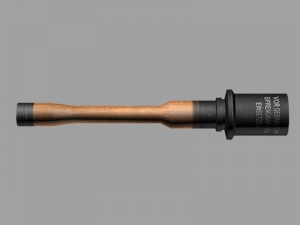Difference between revisions of "Stielhandgranate 24"
| Line 30: | Line 30: | ||
==Game Play== | ==Game Play== | ||
Grenades are used mostly for taking down the various AI you will encounter in game. landing a grenade on the platform of the tower should bring it in blast. other AI is dealt with by throwing a grenade at their feet or anti-tank gun. | |||
Grenades are also used to clear CPs and army base radio rooms. | |||
=See Also= | =See Also= | ||
Revision as of 10:58, 1 August 2020

| |
| Stielhandgranate 24 | |
| Specifications | |
| Type | Hand Grenade |
| Fuse Delay | 4 to 5 Seconds |
| Explosive Type | TNT 168g |
| Effective Blast Radius | 10m to 12m |
History
The German grenades in service during World War II relied on blast (also called concussive effect) rather than fragmentation for effect. The two basic types were the Stielhandgranate (handle hand grenade) stick grenade - often called a potato masher and practically unchanged since World War I - and the smaller, round Eihandgranate (egg hand grenade).
Germany introduced the stick grenade design in 1915. These grenades used friction ignition, a mechanism widely used in German grenades but rarely by other nations. A pull cord ran down the hollow handle, terminating in a porcelain ball. To use the grenade, a soldier pulled the cord and threw stick. When pulled, the cord would draw a roughened steel pin through a sensitive chemical in the head that would then ignite and start the five-second fuse burning.
The first stick grenades had an open bottom from which the cord would dangle. These exposed pull cords could snag and set off a grenade, causing severe injuries, and one of the first improvements to the design was the addition of a metal cap that screwed on the open end of the handle to hide the cord and bead.
The charge of the Stielhandgranate 24 (StiGr 24) consisted of a thin sheet-metal head that contained the high-explosive bursting charge. Because blast, or concussive, effect isn't as lethal over as wide a burst as shrapnel is, Germany kept moving to larger stick grenades. The StiGr 39 was essentially a heavier StiGr 24 with more explosive. After 1942, the StiGr 24 could have its anti-personnel effect enhanced by the manual addition of Splitterringe (shrapnel rings), grooved fragmentation sleeves that clipped over the head of the grenade, but these never saw much use.
While Allied fragmentation grenades were more deadly over a wider area, the German Stielhandgranate could be thrown farther, thanks to the leverage the handle provided.
A later variation, the StiGr 43, had the detonator relocated to the top of the grenade head. This not only simplified manufacture but also allowed soldiers to throw the grenade without the stick or to place them as mines or in booby traps. All stick designs could be hung from fence wire; any disturbance to a dangling grenade would start the fuse. For specialized demolition charges or anti-vehicle work, six StiGr 43 grenade heads could be secured round a seventh in a configuration known as a Geballte Ladung (clenched charge).
Game Play
Grenades are used mostly for taking down the various AI you will encounter in game. landing a grenade on the platform of the tower should bring it in blast. other AI is dealt with by throwing a grenade at their feet or anti-tank gun.
Grenades are also used to clear CPs and army base radio rooms.